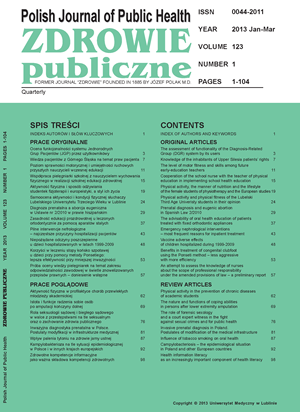The nature and functions of coping abilities in persons after lower extremity amputation
DOI:
https://doi.org/10.12923/j.0044-2011/123-1/a.14Keywords:
coping, amputation, phantom painAbstract
The article contains an overview of the specialist literature to date related to the process of coping with limitations resulting from the loss of a lower limb. The amputation of a lower limb is regarded as a loss: it is accompanied by the feeling of harm, injustice, punishment by fate, but is also perceived in terms of danger or a challenge. Empirical explorations confirm theoretical assumptions, which show a clear correlation between the cognitive evaluation of amputation and the limitations connected with it and the nature of an adopted remedial action. They provide evidence for the dynamics of the coping process, which depends on numerous psychosocial and physical variables. While adapting to life, persons after amputation use both adaptation and non-adaptation strategies. The factor that largely determines their choice of strategy, the frequency of its application and the results obtained, is the time which has elapsed since the operation. A significant plane for the development of the specificity of remedial activities among this group is constituted by coping with phantom pain. The whole process of coping with difficult situations connected with the loss of a lower limb is analyzed in the context of individually experienced adaptation results. The article presents the researchers’ findings concerning the regularities in this regard. The overview contains explanations of the process, which can be found both in the traditional approach (the transactional theory of stress and coping) and the modern approach relying on the indicators of growth and benefit reported after the loss of a lower limb
References
1. Terelak JF. Człowiek i stres. Koncepcje, źródła, reakcje, radzenie so¬bie, modyfikatory. Bydgoszcz-Warszawa: Oficyna Wydawnicza Branta; 2008.
2. Hogan O, MacLachlan M. Psychosocial adjustment to lower-limb am¬putation: A review. Disabil Rehabil. 2004;26(14/15):837-50.
3. Desmond DM, MacLachlan M. Coping strategies as predictors of psy¬chosocial adaptation in a sample of elderly veterans with acquired lower limb amputation. Soc Sci Med. 2006;62(3):208-16.
4. Desmond DM. Coping, affective distress, and psychosocial adjustment among people with traumatic upper limb amputations. J Psychosom Res. 2007;62(1):15-21.
5. Phelps LF, Williams RM, Raichle KA, et al. The importance of cognitive processing to adjustment in the 1st year following amputation. Rehabil Psychol. 2008;53(1):28-38.
6. Hobfoll SE. Stres, kultura i społeczność. Gdańsk: GWP; 2006.
7. Heszen I, Sęk H. Psychologia zdrowia. Warszawa: Wydawnictwo Nau¬kowe PWN; 2007.
8. Elliott TR, Kurylo M, Rivera P. Positive growth following acquired physical disability. In: CR. Snyder, SJ. Lopez (ed). Handbook of positive psychology. Oxford: Oxford University Press; 2002. p. 687-99.
9. Dunn DS. Well-being following amputation: Salutary effects of positive meaning, optimism, and control. Rehabil Psychol. 1996;41(2):285-302.
10. Maes S, Leventhal H, de Ridder DT. Coping with chronic diseases. In: M. Zeidner, NS. Endler (ed). Handbook of coping: Theory, research, ap¬plications. New York: Wiley; 1996. p. 221-51.
11. Chaves JF, Brown JM. Spontaneous cognitive strategies for the control of clinical pain and stress. J Behav Med. 1987;10(3):263-76.
12. Sullivan MJ, Stanish W, Waite H, et al. Catastrophizing, pain, and dis¬ability in patients with soft tissue injuries. Pain. 1998;77(2):253-60.
13. Keefe FJ, Brown GK, Wallston KA, Caldwell DS. Coping with rheu¬matoid arthritis: Catastrophizing as a maladaptive strategy. Pain. 1989;37(1):51-6.
14. Wiech K, Preissl H, Birbaumer N. Neuroimaging of chronic pain: phantom limb and musculoskeletal pain. Scand J Rehabil Med Suppl. 2000;113(1):13-8.
15. Keefe FJ, Lefebvre JC, Smith SJ. Catastrophizing research: avoiding conceptual errors and maintaining a balanced perspective. Pain Forum. 1999;8(1):176-80.
16. Hanley M, Jensen MP, Ehde DM, et al. Psychosocial predictors of long-term adjustment to lower-limb amputation and phantom limb pain. Disa¬bil Rehabil. 2004;26(14/15):882-93.
17. Jensen MP, Ehde DM, Hoffman AJ, et al. Cognitions, coping and so¬cial environment predict adjustment to phantom limb pain. Pain. 2002;95(1):133-42.
18. Davis RW. Phantom sensation, phantom pain, and stump pain. Arch Phys Med Rehabil. 1993;74(1):79-91.
19. Ehde DM, Czarniecki JM, Smith DG, et al. Chronic phantom sensations, phantom pain, residual limb pain, and other regional pain after lower limb amputation. Arch Phys Med Rehabil. 2000;81(6):1039-44.
20. Hill A. The use of pain coping strategies by patients with phantom limb pain. Pain. 1993;55(2):343-7.
21. Hill A, Niven CA, Knussen C. The role of coping in adjustment to phan¬tom limb pain. Pain. 1995;62(1):79-86.
22. Jensen MP, Turner JA, Romano JM, Karoly P. Coping with chronic pain: a critical review of the literature. Pain. 1991;47(2):249-83.
23. Turner JA, Jensen MP, Romano JM. Do beliefs, coping, and catastro¬phizing independently predict functioning in patients with chronic pain? Pain. 2000;85(1):115-25.
24. Pucher I, Kickinger W, Fischenschlager O. Coping with amputation and phantom limb pain. J Psychosom Res. 1999;46(4):379-83.
25. Falvo DR. Medical and psychosocial aspects of chronic illness and dis¬ability. Gaithersburg MD: Aspen; 1999.
26. Szychowiak B. Wychowanie dzieci niesprawnych ruchowo. In: I. Obu¬chowska (ed). Dziecko niepełnosprawne w rodzinie. Warszawa: WSziP; 1999. p. 379-414.
27. Livneh H, Antonak R, Gerhardt J. Psychosocial adaptation to amputa¬tion: the role of sociodemographic variables, disability related factors and coping strategies. Int J Rehabil Res. 1999;22(1):21-31.
28. Gallagher P, MacLachlan M. Psychological adjustment and coping in adults with prosthetic limbs. Behav Med. 1999;25(3):117-24.
29. Sjödahl C, Gard G, Jarnlo GB. Coping after trans-femoral amputation due to trauma or tumour – a phenomenological approach. Disabil Reha¬bil. 2004;26(14-15):851-61.
30. Mattlin JA, Wethington E, Kessler RC. Situational determinants of cop¬ing and coping effectiveness. J Health Soc Behav. 1990;31(1):103-22.
31. Rybarczyk B, Edwards R, Behel J. Diversity in adjustment to a leg amputation: Case illustrations of common themes. Disabil Rehabil. 2004;26(14/15):944-53.
32. Livneh H, Antonak R, Gerhardt J. Multidimensional investigation of the structure of coping among people with amputation. Psychosom. 2000;41(2):235-44.
33. Oaksford K, Frude N, Cuddihy R. Positive coping and stress-related psychological growth following lower limb amputation. Rehabil Psy¬chol. 2005;50(3):266-77.
34. Atherton R, Robertson N. Psychological adjustment to lower limb am¬putation amongst prosthesis users. Disabil Rehabil. 2006;28(19):1201-9.


